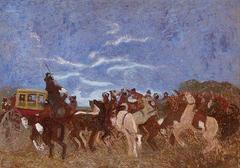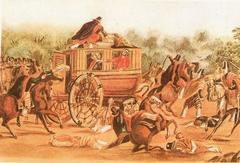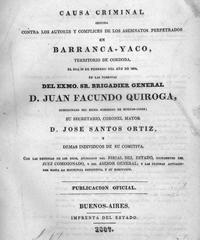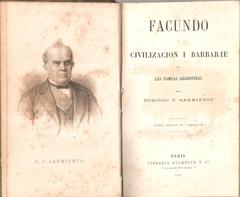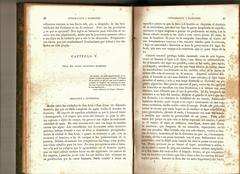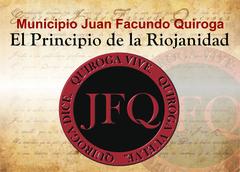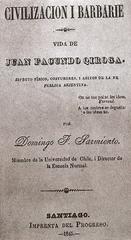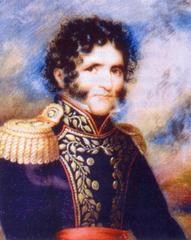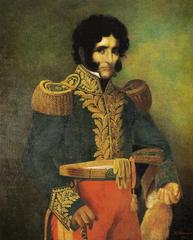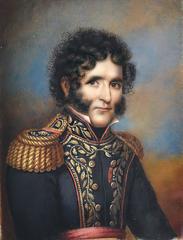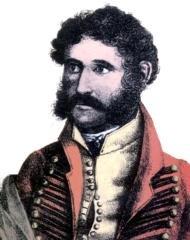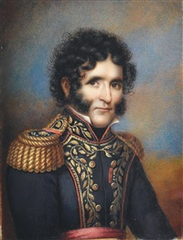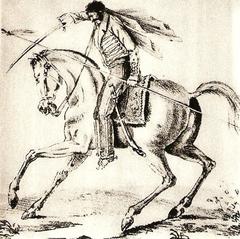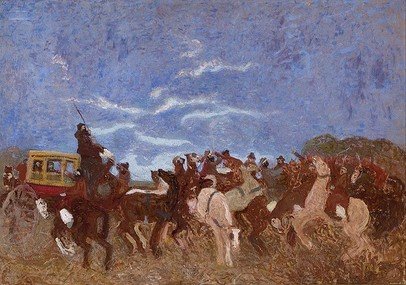
Facundo Quiroga Buenos Aires: Visiting Hours, Tickets, and Travel Guide
Date: 14/06/2025
Introduction to Facundo Quiroga and What to Expect When Visiting
Facundo Quiroga, located in the heart of Buenos Aires Province, Argentina, is a rural locality steeped in historical and cultural significance. Named after the 19th-century federalist leader Juan Facundo Quiroga—known as “El Tigre de los Llanos”—the town provides visitors with a unique window into Argentina’s formative years, agrarian traditions, and railway heritage. Originally part of vast estancias, the arrival of the Ferrocarril Oeste railway in the early 20th century marked a turning point, sparking economic and social transformation (Wikipedia).
Walking the charming streets of Facundo Quiroga, visitors encounter living memorials to its namesake’s complex legacy. Cultural sites such as the Biblioteca Popular Armonía G. de Schejtman, local museums, and the town theater celebrate community life, heritage, and the arts (Canal26). For a broader historical context, the Museo Histórico y Numismático “Héctor Carlos Janson” in Buenos Aires city features numismatic collections and exhibits on the “Tapados de Quiroga”—buried coins linked to the civil wars (Museo Héctor Carlos Janson).
This guide offers a comprehensive overview, including the town’s evolution, practical visitor information, transportation, accommodation, and local customs. Whether your interest lies in Argentina’s history, regional festivals, or rural exploration, you’ll find essential resources for planning a memorable visit (La Guía 2000).
Table of Contents
- Early Settlement and Land Ownership
- The Arrival of the Railway and Town Formation
- Social and Labor Movements
- Naming and Historical Significance
- The Legacy of Juan Facundo Quiroga
- Cultural and Social Development
- Architectural and Urban Heritage
- Notable Residents and Contributions
- Visiting Facundo Quiroga: Practical Information for Tourists
- Visual Highlights
- Frequently Asked Questions (FAQ)
- Museo Histórico y Numismático Héctor Carlos Janson: Visiting Hours & Buenos Aires Historical Sites
- Visiting Facundo Quiroga: Travel Tips, Accommodation & Local Culture
- Summary and Planning Your Visit
- References
Early Settlement and Land Ownership
Facundo Quiroga’s origins date back to the late 19th century, when the area was part of large rural estates. In 1867, Alfredo Demarchi purchased land from Carlos Salas, establishing the estancia El Socorro with a focus on cattle breeding, particularly Shorthorn cattle. This agricultural foundation shaped the local economy and social structure for generations (Wikipedia).
The Arrival of the Railway and Town Formation
In the early 20th century, the expansion of the Ferrocarril Oeste (Western Railway) fundamentally changed the region. Land was donated by the Demarchi family for a new station, and the request was made to name it after Juan Facundo Quiroga. While the provincial government officially named the town after Alfredo Demarchi, the station and locality became popularly known as Facundo Quiroga (Wikipedia).
The railway’s presence brought economic growth, new residents, and vital infrastructure. The establishment of railway workshops became an economic and social hub, fostering a strong sense of community.
Social and Labor Movements
The railway workshops were central to the town’s history. In 1923, a significant labor strike occurred, influenced by anarchist movements, culminating in the burning of the workshops. The railway company subsequently moved facilities elsewhere, which deeply affected the local economy and altered the town’s development (Wikipedia).
Naming and Historical Significance
The town’s identity is inseparable from Juan Facundo Quiroga, the legendary caudillo of the Argentine civil wars. Many streets are named after key events and locales from his life, serving as a living tribute to his ongoing influence on national history (Encyclopedia.com).
The Legacy of Juan Facundo Quiroga
Born in La Rioja in 1788, Juan Facundo Quiroga became a defining figure in Argentina’s struggles between federalist and centralist forces. A skilled leader, he inspired loyalty among rural gauchos and challenged centralist policies. His military and political exploits—such as the battles of La Tablada and Oncativo—are legendary (Caras y Caretas). His assassination in 1835 marked a dramatic turning point in Argentine politics (Encyclopedia.com).
Cultural and Social Development
After the railway era, Facundo Quiroga evolved as a vibrant rural community. Institutions like the Biblioteca Popular Armonía G. de Schejtman, local museums, and the Club Atlético Quiroga (founded in 1917) reflect the town’s commitment to culture, education, and sports (Wikipedia). Annual festivities and commemorations celebrate both the town’s namesake and its regional heritage.
Architectural and Urban Heritage
The town’s layout and architecture echo its railway origins. The historic station, community buildings, and street names all reinforce the town’s connection to the legacy of Juan Facundo Quiroga (Wikipedia).
Notable Residents and Contributions
Facundo Quiroga has produced notable personalities, such as actor Héctor Pellegrini (“La Patagonia Rebelde”) and footballer José Paradela, who have contributed to Argentine culture and sports (Wikipedia).
Visiting Facundo Quiroga: Practical Information for Tourists
Visiting Hours and Tickets
- Museums and Library: Open Tuesday to Saturday, 9 AM to 5 PM. Admission is free; donations are welcome.
- Theater: Event schedules vary; check the town’s official website or local tourist offices.
Guided Tours and Travel Tips
- Guided tours: Focus on railway history and Juan Facundo Quiroga’s legacy. Book in advance through local operators.
- Best time to visit: Spring (September–November) and fall (March–May) for mild weather.
- Footwear: Wear comfortable shoes to explore town streets and historical sites.
Accessibility
- Public buildings: Most are wheelchair accessible.
- Older structures: Some may have limited access due to historical construction.
Nearby Attractions
- Other towns: Bragado and General Pico offer additional historical sites and natural parks.
- Countryside: The surrounding area is ideal for rural tourism and scenic drives.
Visual Highlights
The historic railway station, a central landmark in Facundo Quiroga.
Statue honoring the legendary caudillo Juan Facundo Quiroga.
Frequently Asked Questions (FAQ)
Q: What are the opening hours for the Facundo Quiroga museum?
A: Tuesday to Saturday, 9 AM to 5 PM.
Q: Is there an entrance fee for cultural sites?
A: Admission to the museum and library is free.
Q: Are guided tours available?
A: Yes, by appointment through local operators.
Q: What is the best time of year to visit?
A: Spring and fall offer pleasant weather.
Q: How do I get to Facundo Quiroga from Buenos Aires?
A: By regional bus or car, located centrally in Buenos Aires Province.
Museo Histórico y Numismático Héctor Carlos Janson: Visiting Hours & Buenos Aires Historical Sites
Overview
The Museo Histórico y Numismático “Héctor Carlos Janson” in Buenos Aires is a must-visit for those interested in Argentina’s monetary and civil war history, especially the “Tapados de Quiroga”—treasures buried during the federalist conflicts (Museo Héctor Carlos Janson).
Practical Information
- Location: San Martín 216, Buenos Aires
- Hours: Monday to Friday, 10 AM to 4 PM
- Admission: Free (as of June 2025)
- Guided Tours: Book in advance; available in Spanish and English
- Accessibility: Wheelchair accessible
Highlights
- Exhibits: Coins and minting tools from the 1820s, including items linked to Facundo Quiroga.
- Walking tours: Explore Buenos Aires streets and plazas named after Quiroga and other federalist landmarks.
FAQs
-
Q: Is there an entrance fee?
A: No, admission is free. -
Q: Are guided tours available?
A: Yes, in multiple languages by prior arrangement. -
Q: Is the museum accessible?
A: Yes, facilities for visitors with reduced mobility.
Visiting Facundo Quiroga: Travel Tips, Accommodation & Local Culture
Getting There
- By car: About 300 km from Buenos Aires city, via National Route 5 and provincial roads.
- By bus: Travel to Nueve de Julio, then taxi or remise to Facundo Quiroga. Check schedules in advance (Infomiba).
Accommodation and Dining
- Lodging: Limited to guesthouses and estancias; book ahead. More options in Nueve de Julio.
- Dining: Local cuisine includes empanadas, milanesas, and asado. Most establishments accept cash only.
Safety & Practicalities
- Safety: Low crime; general precautions suffice.
- Medical services: Basic care locally; nearest hospital in Nueve de Julio.
- Cash: Essential; no ATMs in town (Secrets of Buenos Aires).
- Connectivity: Mobile coverage is reliable; Wi-Fi is rare, so consider a local SIM card.
Best Time to Visit
- Spring and autumn for mild weather and lush landscapes.
- Check with local tourism sources for festival dates.
Cultural Etiquette
- Be respectful of local customs and mate rituals.
- Spanish is the primary language; use basic phrases.
- Modest, comfortable clothing is advised for community events.
Packing Tips
- Cash (Argentine pesos)
- Identification
- Comfortable shoes and sun protection
- First-aid kit and medications
- Translation app or phrasebook
- Snacks and bottled water
Accessibility
- Flat terrain and paved streets; some rural sites may require walking on dirt paths.
Responsible Tourism
- Minimize noise and litter
- Support local businesses
- Ask permission before visiting private properties
Emergency Contacts
- Police: 101
- Medical: 107
- Nearest hospital: Nueve de Julio Hospital
Summary and Planning Your Visit
Facundo Quiroga embodies Argentina’s historic struggles, community spirit, and rural traditions. From its roots as a cattle estate to its pivotal railway legacy, the town offers a rich tapestry of experiences, from museums and commemorative events to architectural heritage. The legacy of Juan Facundo Quiroga is visible everywhere, connecting visitors to Argentina’s federalist past (Encyclopedia.com).
Travelers can enjoy guided tours, cultural events, and authentic rural hospitality. The Museo Histórico y Numismático Héctor Carlos Janson in Buenos Aires city complements the experience with its numismatic collections. For a rewarding visit, plan ahead, respect local customs, and use the Audiala app for interactive maps and exclusive content.
References and Useful Links
- Wikipedia
- Encyclopedia.com
- La Guía 2000
- Canal26
- Infomiba
- Caras y Caretas
- Museo Héctor Carlos Janson
- Secrets of Buenos Aires
Explore more about Buenos Aires Province and rural tourism on our site. Download the Audiala app for personalized guides, event updates, and travel tips for Facundo Quiroga and beyond.
